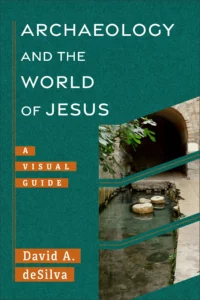Book Giveaway
Sponsored by Baker Academic
Enter to win a free copy of Engaging the New Testament by reposting our X post about the giveaway. Find us on Twitter at @everyvoicekd.
About Archaeology and the World of Jesus
An interview with David A. deSilva
EV: What led you to put this book together? What problem or issue(s) are you seeking to address?
DD: Visiting and studying the remains of the lived spaces of the characters of the Gospels and the earliest communities of Christ-followers significantly enriched my own reading of the Gospels. My imagination was no longer informed merely by the sets constructed for one or another Jesus film (or worse), but by first-hand experience of those spaces. The stage, as it were, for the action of the Gospels was far better set in my mind. My thinking about the ways in which those who encountered Jesus might have processed his teachings and actions, given the realities they would continue to encounter, was better informed. My
understanding of the political, religious, social, and ethnic dynamics that surrounded each episode – and the communities of the Jesus movement that continued and grew into the first century – more robust. I wrote this book to try to make that accessible to those who had not had the opportunities for extensive
travel and study that I had enjoyed, to help prepare groups who were about to embark on such travel, and to assist the ongoing reflection of people who had visited sites in Israel, Jordan, and the Palestinian Territories.
EV: What’s the thesis of your book?
DD: This book is not so much about the promotion of a thesis as an immersion in contexts. But if there is an underlying conviction to this book, as to its prequel and sequel (Archaeology and the Ministry of Paul, Baker Academic, 2025; Archaeology and the Book of Revelation, Baker Academic, forthcoming), it is that
the New Testament scriptures emerge from the real-life experience of Jesus, his envoys, and the earliest Christian movement and that the deeper our immersion into the circumstances of the latter, the richer, the more three-dimensional, our engagement with the former.
EV: Who’s your target audience, and what are you most hoping they hear from it?
DD: I hope that all readers will hear that the New Testament scriptures are best engaged not as disembodied words on a page that communicate abstract ideas and morals, but as voices speaking from real spaces in a historical landscape, much of which we can reconstruct, to people seeking to live into the new reality of the “kingdom of God” amidst the very solid structures of the “kingdom of this world.”
On the one hand, I hope the book will become a standard textbook in seminary and undergraduate courses in Archaeology and the New Testament or, perhaps, a supplementary text in courses on the Gospels. Thanks to the Catholic Biblical Association and the incredible gift of a visiting professorship at the École biblique et archéologique française in Jerusalem, I was able to access a wealth of research on the archaeology of each site and the interpretation of the remains, and so the running text rests upon very strong foundations. On the other hand, I am deeply invested in the education of Christian lay persons and I wrote this book at a level that anyone invested enough in his or her own education in the
faith to be a regular participant in adult Bible studies would find accessible, perhaps even winsome. And Baker Publishing Group really produced a beautiful volume, generous with space for about 250 photos of sites and artifacts and all on high-quality, no-ghosting paper.
EV: Did you have any “aha” moments while editing the book?
DD: I think that the “aha” moment came in the course of my visits to particular sites over the course of the last decade – and there were plenty of these! Writing the book gave me the opportunity and the pleasure to remember, reflect upon, and record them.
EV: What was the most challenging part of the book project?
DD: There are certain sites that are prominent in the Gospels (and so could hardly be omitted!) but whose identification remains uncertain and in regard to which archaeological work is severely lacking. So I suppose I would regard the chapters on Cana and Emmaus, for example, as real challenges (and ultimately less than satisfactory), whereas the abundance of archaeological work at so many other sites made those chapters an easy task (save for the challenge of keeping those chapters to manageable lengths).
EV: If your book was made into a movie, what actor/actress would play the lead role?
DD: Jonathan Roumie is rumored to have a lead.
EV: What kind of seminary/church classes should assign your book?
DD: Again, I would hope to see this book considered as a main text for courses in New Testament Archaeology or as a supplementary text in courses on the Gospels, the Historical Jesus, or New Testament Introduction more broadly. In church settings, this would be an obvious companion volume for groups
preparing for a journey to Israel, the Palestinian Territories, and/or Jordan.
Groups spending a semester or so working through one of the four Gospels would also find this book to provide a means by which to bring the many settings of events narrated therein into clearer view.
About the Author

David A. deSilva (PhD, Emory University) is Trustees’ Distinguished Professor of New Testament and Greek at Ashland Theological Seminary and an ordained elder in the Global Methodist Church.

